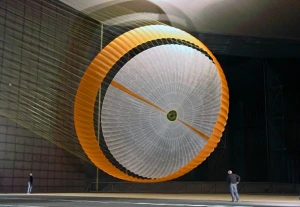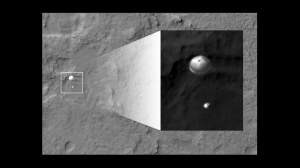The Martian atmosphere lies low and thin. There’s not enough of it to land softly by parachute alone. But when you come screaming in a little over 3.5 miles per second, it’s almost more like water than air.
The Mars Science Laboratory hit the atmosphere at 13,000 mph and slowed to 900 mph on atmospheric friction alone. Peak heating during this period is twice as hot as melted rock, or lava.
Then it popped a parachute. There’s enough atmosphere at the altitude of six miles – about the same height as a jet airliner over Earth – for a parachute to slow everything down a lot.
Here’s that parachute during indoor testing on Earth:
Even in a very thin atmosphere, popping a chute at 900 mph creates a lot of stress, about 9 Gs. How do you test for that? With a helicopter, a rocket sled and a lot of very strong cable. Watch to 4:00 to see the big picture:
You can do more than see this parachute. You can ride it down. Twenty seconds after the parachute was deployed, the heat shield was dropped while the rover was 5 miles above the surface and falling a bit over 500 mph. That’s where the ride begins:
Images have been captured of the parachute in its final resting place.
It’s still blowing in the Martian winds.


